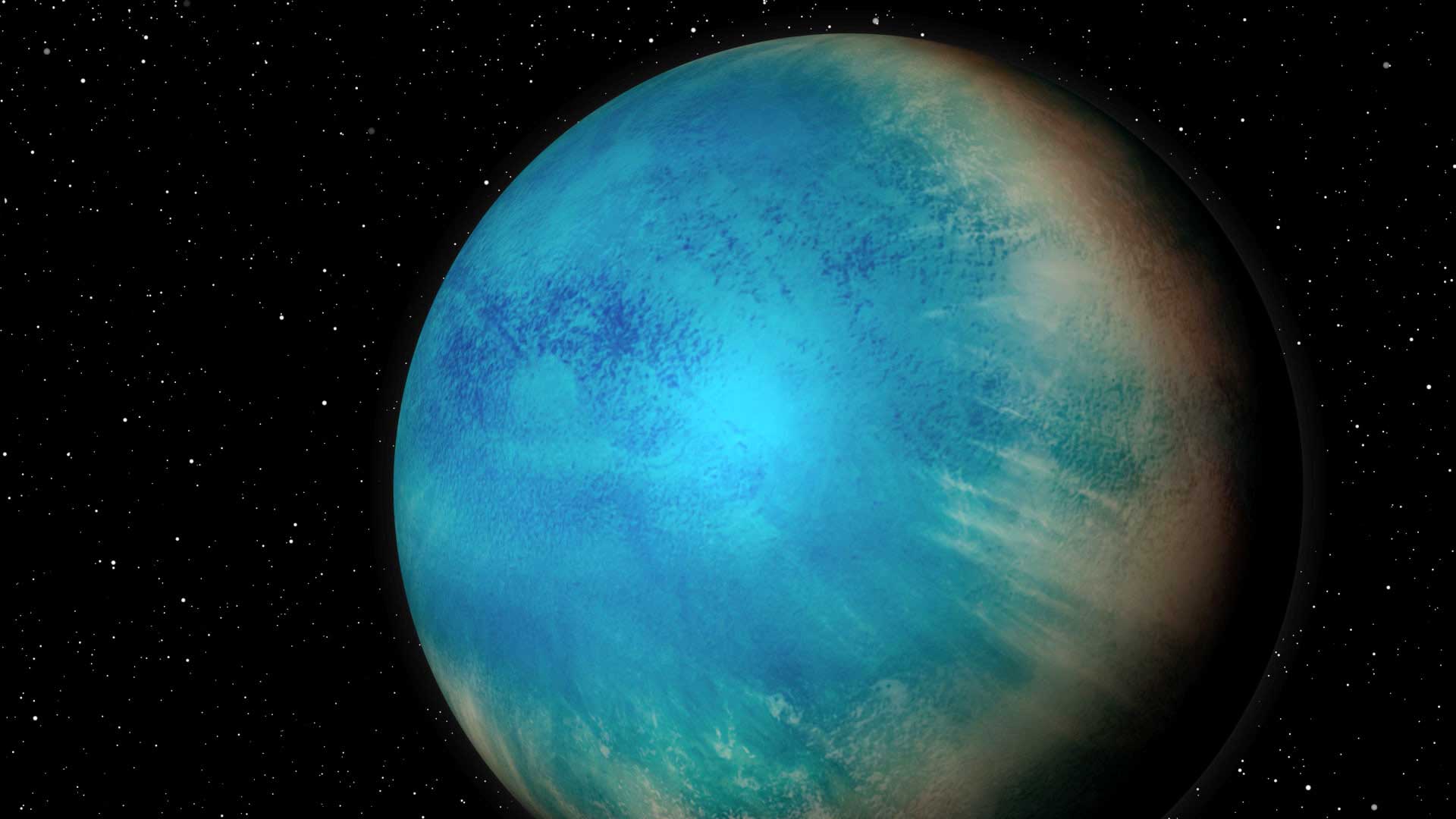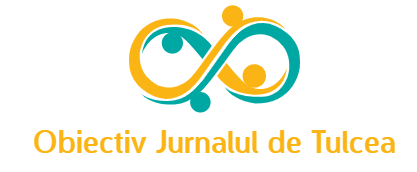
Traducere tehnică a exoplanetei TOI-1452 b, o planetă minoră care poate fi complet acoperită în adâncurile oceanului. Credit: Benoit Gougeon, Universitatea din Montreal
Cu ajutorul instrumentelor proiectate parțial în Canada, o echipă de astronomi a descoperit[{” attribute=””>exoplanet that could be completely covered in water.
An international team of scientists has announced the discovery of TOI-1452 b, an exoplanet orbiting one of two small stars in a binary system located in the Draco constellation about 100 light-years from Earth. The researchers were led by Charles Cadieux, a Ph.D. student at the Université de Montréal and member of the Institute for Research on Exoplanets (iREx).
With a size and mass slightly greater than that of Earth, the exoplanet is located at a distance from its star where its temperature would be neither too hot nor too cold for liquid water to exist on its surface. The astronomers believe it could be an “ocean planet,” a planet completely covered by a thick layer of water. This would make it similar to some of the moons of Jupiter and Saturn.
Cadieux and his team describe the observations that elucidated the nature and characteristics of this unique exoplanet in an article published on August 12 in The Astronomical Journal.

Artistic representation of the surface of TOI-1452 b, which could be an “ocean planet”, i.e. a planet entirely covered by a thick layer of liquid water. Credit: Benoit Gougeon, Université de Montréal
“I’m extremely proud of this discovery because it shows the high calibre of our researchers and instrumentation,” said René Doyon, Université de Montréal Professor and Director of iREx and of the Observatoire du Mont-Mégantic (OMM). “It is thanks to the OMM, a special instrument designed in our labs called SPIRou, and an innovative analytic method developed by our research team that we were able to detect this one-of-a-kind exoplanet.”
It was NASA’s space telescope TESS, which surveys the entire sky in search of planetary systems close to our own, that put the astronomers on the trail of this exoplanet. Based on the TESS signal, which showed a slight decrease in brightness every 11 days, scientists predicted a planet about 70% larger than Earth.
Charles Cadieux belongs to a group of astronomers that does ground follow-up observations of candidates identified by TESS in order to confirm their planet type and characteristics. He uses PESTO, a camera installed on the OMM’s telescope that was developed by Université de Montréal Professor David Lafrenière and his Ph.D. student François-René Lachapelle.
O echipă internațională de astronomi a descoperit o exoplanetă care ar putea fi acoperită complet de apă. Credit: Benoit Gougeon, Universitatea din Montreal
„OMM a jucat un rol important în confirmarea naturii acestui semnal și estimarea razei planetei”, a explicat Cadeaux. „Acesta nu a fost o verificare de rutină. Trebuia să ne asigurăm că semnalul detectat de TESS a fost într-adevăr cauzat de o exoplanetă care orbitează TOI-1452, cele două cele mai mari stele din acel sistem binar.”
Steaua gazdă TOI-1452 este mult mai mică decât soarele nostru și una dintre cele două stele de dimensiuni similare din sistemul binar. Cele două stele orbitează între ele și sunt separate de o distanță mică – 97 de unități astronomice, sau aproximativ de două ori și jumătate distanța dintre Soare și[{” attribute=””>Pluto — that the TESS telescope sees them as a single point of light. But PESTO’s resolution is high enough to distinguish the two objects, and the images showed that the exoplanet does orbit TOI-1452, which was confirmed through subsequent observations by a Japanese team.
Ingenuity at work
To determine the planet’s mass, the astronomers then observed the system with SPIRou, an instrument installed on the Canada-France-Hawaii Telescope in Hawai’i. Designed in large part in Canada, SPIRou is ideal for studying low-mass stars such as TOI-1452 because it operates in the infrared spectrum, where these stars are brightest. Even then, it took more than 50 hours of observation to estimate the planet’s mass, which is believed to be nearly five times that of Earth.
Étienne Artigau and Neil Cook, researchers also with iREx at the Université de Montréal, played a key role in analyzing the data. They developed a powerful analytic method capable of detecting the planet in the data collected with SPIRou. “The LBL method [for line-by-line] Ne permite să curățăm datele obținute cu SPIRou din multe dintre semnalele paraziților și să dezvăluim semnătura slabă a planetelor precum cele descoperite de echipa noastră”, a explicat Artigau.
Echipa include, de asemenea, cercetătorii Quebec Farbod Jahandar și Thomas Vandal, care au doctorat. Studenți de la Universitatea din Montreal. Jahandar a analizat compoziția stelei gazdă, care este utilă pentru constrângerea structurii interne a planetei, în timp ce Vandal a participat la analiza datelor colectate cu SPIRou.
lumea apei
Deși exoplaneta TOI-1452 b poate fi la fel de stâncoasă ca Pământul, raza, masa și densitatea ei sugerează o lume foarte diferită de a noastră. Pământul este practic o planetă foarte uscată. Deși uneori o numim planeta albastră, deoarece aproximativ 70% din suprafața sa este acoperită de ocean, apa reprezintă de fapt doar un procent mic din masa sa – mai puțin de 1%.
Apa poate fi mai abundentă pe unele exoplanete. În ultimii ani, astronomii au determinat și determinat raza și masa multor exoplanete cu dimensiuni de la Pământ la[{” attribute=””>Neptune (about 3.8 times larger than Earth). Some of these planets have a density that can only be explained if a large fraction of their mass is made up of lighter materials than those that make up the internal structure of the Earth such as water. These hypothetical worlds have been dubbed “ocean planets.”
“TOI-1452 b is one of the best candidates for an ocean planet that we have found to date,” said Cadieux. “Its radius and mass suggest a much lower density than what one would expect for a planet that is basically made up of metal and rock, like Earth.”
The University of Toronto’s Mykhaylo Plotnykov and Diana Valencia are specialists in exoplanet interior modeling. Their analysis of TOI-1452 b shows that water may make up as much as 30% of its mass, a proportion similar to that of some natural satellites in our Solar System, such as Jupiter’s moons Ganymede and Callisto, and Saturn’s moons Titan and Enceladus.
To be continued…
An exoplanet such as TOI-1452 b is a perfect candidate for further observation with the James Webb Space Telescope, or Webb for short. It is one of the few known temperate planets that exhibit characteristics consistent with an ocean planet. It is close enough to Earth that scientists can hope to study its atmosphere and test this hypothesis. And, in a stroke of good fortune, it is located in a region of the sky that the telescope can observe year-round.
“Our observations with the Webb Telescope will be essential to better understanding TOI-1452 b,” said Doyon who overviewed the conception of James Webb’s component Near Infrared Imager and Slitless Spectrograph (NIRISS). “As soon as we can, we will book time on Webb to observe this strange and wonderful world.”
Reference: “TOI-1452 b: SPIRou and TESS reveal a super-Earth in a temperate orbit transiting an M4 dwarf” by Charles Cadieuxg, René Doyon, Mykhaylo Plotnykov, Guillaume Hébrard, Farbod Jahandar, Étienne Artigau, Diana Valencia, Neil J. Cook, Eder Martioli, Thomas Vandal, Jean-François Donati, Ryan Cloutier, Norio Narita, Akihiko Fukui, Teruyuki Hirano, François Bouchy, Nicolas B. Cowan, Erica J. Gonzales, David R. Ciardi, Keivan G. Stassun, Luc Arnold, Björn Benneke, Isabelle Boisse, Xavier Bonfils, Andrés Carmona, Pía Cortés-Zuleta, Xavier Delfosse, Thierry Forveille, Pascal Fouqué, João Gomes da Silva, Jon M. Jenkins, Flavien Kiefer, Ágnes Kóspál, David Lafrenière, Jorge H. C. Martins, Claire Moutou, J.-D. do Nascimento Jr., Merwan Ould-Elhkim, Stefan Pelletier, Joseph D. Twicken, Luke G. Bouma, Scott Cartwright, Antoine Darveau-Bernier, Konstantin Grankin, Masahiro Ikoma, Taiki Kagetani, Kiyoe Kawauchi, Takanori Kodama, Takayuki Kotani, David W. Latham, Kristen Menou, George Ricker, Sara Seager, Motohide Tamura, Roland Vanderspek and Noriharu Watanabe, 12 August 2022, The Astronomical Journal.
DOI: 10.3847/1538-3881/ac7cea
The article was published on August 12, 2022, in The Astronomical Journal. In addition to Charles Cadieux, René Doyon, Étienne Artigau, Neil Cook, Farbod Jahandar and Thomas Vandal at the Université de Montréal’s iREx, the research team includes Nicolas B. Cowan (iREx, MSI, McGill, Canada); Björn Benneke, Stefan Pelletier and Antoine Darveau-Bernier (iREx, UdeM, Canada); Ryan Cloutier, former member of iREx (Harvard, U.S.); and co-authors from University of Toronto, France, Brazil, the United States, Japan, Spain, Switzerland, Portugal, Hungary, Germany, and Crimea.

„Mândru pasionat al rețelelor sociale. Savant web fără scuze. Guru al internetului. Pasionat de muzică de-o viață. Specialist în călătorii.”




More Stories
Cercetătorii de la Universitatea din Utah colectează mostre pentru a mapa răspândirea febrei văii prin sporii de murdărie
Un asteroid mare a trecut în siguranță pe lângă Pământ: vezi imaginea aici!
NASA stabilește cursul pentru returnarea probelor de pe Marte și caută modele inovatoare